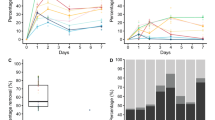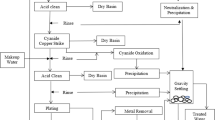Abstract
Clinical solid waste contains pathogenic microorganisms and therefore requires effective sterilization prior to safe handling and disposal. This work deals with the inactivation of Aspergillus niger, Aspergillus terreus var. terreus and Penicillium simplicissimum spores in clinical solid waste using supercritical carbon dioxide (SC-CO2) as a waterless sterilization technology. The artificial neural network (ANN) approach was used to study the behavior of the fungal spores for the pressure, temperature, time and initial fungal spore concentrations. The optimal operating parameters were 35 MPa, 35 °C, 100-min treatment time with 6 log10 spores g−1: the predicted and experimental results were 5.48 and 5.96 logs of A. niger, 5.56 and 5.96 logs of A. terreus var. terreus, 5.84 and 5.99 log reduction of P. simplicissimum. ANN analysis revealed that temperature, time and initial concentrations showed a greater influence on the inactivation of the fungal spore’s inactivation. Inactivation results from destructing the cell wall, as evidenced by the lack of growth of fungi in the culture medium, indicating complete inactivation of the fungal spores. The findings of the present study would be useful in implementing the sustainable utilization of clinical solid waste materials.











Similar content being viewed by others
Data availability
Not applicable.
References
Al-Fasih M, Huseien G, bin Ibrahim I, Sam M, Algaifi H, Alyousef R (2021) Synthesis of rubberized alkali-activated concrete: experimental and numerical evaluation. Constr Build Mater 303:124526. https://doi.org/10.1016/j.conbuildmat.2021.124526
Al-Gheethi A, Noman E, Mohamed R, Talip B, Vo D, Algaifi A (2021) Cephalexin removal by a novel Cu–Zn bionanocomposite biosynthesized in secondary metabolic products of Aspergillus arenarioides EAN603 with pumpkin peels medium: optimization, kinetic and artificial neural network models. J Hazard Mater 419:126500. https://doi.org/10.1016/j.jhazmat.2021.126500
APHA (2005) Standard Methods for the Examination of Water and Wastewater, 21st edn. American Public Health Association/American Water Works Association/Water Environment Federation, Washington DC
Borg FG (2003) What is osmosis? Explanation and understanding of a physical phenomenon. arXiv preprint physics/0305011
Caldwell J (1965) Effects of high partial pressures of oxygen on fungi and bacteria. Nature 206(4981):321–323. https://doi.org/10.1038/206321a0
Calvo L, Torres E (2010) Microbial inactivation of paprika using high-pressure CO2. J Supercrit Fluids 52(1):134–141. https://doi.org/10.1016/j.supflu.2016.04.012
Efaq A, Rahman A, Nagao H, Al-Gheethi A, Kadir M (2017) Inactivation of Aspergillus spores in clinical wastes by supercritical carbon dioxide. Arab J Sci Eng 42(1):39–51. https://doi.org/10.1007/s13369-016-2087-5
Eissa ME, Abd El Naby M, Beshir MM (2014) Bacterial vs. fungal spore resistance to peroxygen biocide on inanimate surfaces. Bull Fac Pharm Cairo Univ 52(2):219–224. https://doi.org/10.1016/j.bfopcu.2014.06.003
Hardison SE, Brown GD (2012) C-type lectin receptors orchestrate antifungal immunity. Nat Immunol 13(9):817–822. https://doi.org/10.1038/ni.2369
Hossain MS, Ab Rahman NNN, Balakrishnan V, Alkarkhi AF, Rajion ZA, Ab Kadir MO (2015) Optimizing supercritical carbon dioxide in the inactivation of bacteria in clinical solid waste by using response surface methodology. Waste Manage 38:462–473. https://doi.org/10.1016/j.wasman.2015.01.003
Hossain MS, Rahman NNNA, Balakrishnan V, Rajion ZA, Kadir MOA (2015) Mathematical modeling of Enterococcus faecalis, Escherichia coli, and Bacillus sphaericus inactivation in infectious clinical solid waste by using steam autoclaving and supercritical fluid carbon dioxide sterilization. Chem Eng J 267:221–234. https://doi.org/10.1016/j.cej.2014.07.097
Jung JH, Lee JE, Lee CH, Kim SS, Lee BU (2009) Treatment of fungal bioaerosols by a high-temperature, short-time process in a continuous-flow system. Appl Environ Microbiol 75(9):2742–2749. https://doi.org/10.1128/AEM.01790-08
Kamihira M, Taniguchi M, Kobayashi T (1987) Sterilization of microorganisms with supercritical carbon dioxide. Agric Biol Chem 51(2):407–412. https://doi.org/10.1080/00021369.1987.10868053
Mannaa M, Kim KD (2017) Influence of temperature and water activity on deleterious fungi and mycotoxin production during grain storage. Mycobiology 45(4):240–254
Mazia D, Schatten G, Sale W (1975) Adhesion of cells to surfaces coated with polylysine. Applications to electron microscopy. J Cell Biol 66(1):198–200. https://doi.org/10.1083/jcb.66.1.198
Mohamed R, Al-Gheethi A, Abdulrahman A, Bin Sainudin MS, Bakar SA, Kassim AHM (2018) Optimization of ceramic waste filter for bathroom greywater treatment using central composite design (CCD). J Environ Chem Eng 6(2):1578–1588. https://doi.org/10.1016/j.jece.2018.02.006
Neely AN, Orloff MM (2001) Survival of some medically important fungi on hospital fabrics and plastics. J Clin Microbiol 39(9):3360–3361. https://doi.org/10.1128/JCM.39.9.3360-3361.2001
Noman EA, Al-Gheethi A, Rahman N, Nagao H, Kadir A (2016a) Assessment of relevant fungal species in clinical solid wastes. Environ Sci Poll Res 23:19806–19824. https://doi.org/10.1007/s11356-016-7161-8
Noman EA, Rahman NN, Shahadat M, Nagao H, Al-Karkhi AF, Al-Gheethi A, …, Omar A K (2016b) Supercritical fluid CO2 technique for destruction of pathogenic fungal spores in solid clinical wastes. CLEAN Soil Air Water 44(12):1700–1708. https://doi.org/10.1002/clen.201500538
Noman E, Ab Rahman NNN, Al-Gheethi A, Nagao H, Talip BA, Kadir OA (2018) Selection of inactivation medium for fungal spores in clinical wastes by supercritical carbon dioxide. Environ Sci Pollut Res 25(22):21682–21692. https://doi.org/10.1007/s11356-018-2335-1
Omar AM, Norsalwani TT, Khalil HA, Nagao H, Zuknik MH, Hossain MS, Norulaini NN (2017) Waterless sterilization of oil palm fruitlets using supercritical carbon dioxide. J Supercrit Fluids 126:65–71. https://doi.org/10.1016/j.supflu.2017.02.019
Park HS, Kim KH (2013) Enhancement of supercritical $ CO_2 $ inactivation of spores of Penicillium oxalicum by ethanol cosolvent. J Microbiol Biotechnol 23(6):833–836. https://doi.org/10.4014/jmb.1211.11072
Park HS, Choi HJ, Kim KH (2012) Inactivation of Alternaria brassicicola spores by supercritical carbon dioxide with ethanol entrainer. J Microbiol Methods 88(1):185–187. https://doi.org/10.1016/j.mimet.2011.11.005
Robb SM (1966) Reactions of fungi to exposure to 10 atmospheres pressure of oxygen. Microbiology 45(1):17–29. https://doi.org/10.1099/00221287-45-1-17
Shimoda M, Kago H, Kojima N, Miyake M, Osajima Y, Hayakawa I (2002) Accelerated death kinetics of Aspergillus niger spores under high-pressure carbonation. Appl Environ Microbiol 68(8):4162–4167. https://doi.org/10.1128/AEM.68.8.4162-4167.2002
STAATT (2005) Technical assistance manual: state regulatory oversight of medical waste treatment technology. Report of the state and territorial association on alternative treatment technologies
Stevenson A, Cray J, Williams J, Santos R, Sahay R, Neuenkirchen N, McClure C, Grant I, Houghton J, Quinn J, Timson D (2015) Is there a common water-activity limit for the three domains of life? ISME J 9:1333–1351. https://doi.org/10.1038/ismej.2014.219
Valverde MT, Marín-Iniesta F, Calvo L (2010) Inactivation of Saccharomyces cerevisiae in conference pear with high pressure carbon dioxide and effects on pear quality. J Food Eng 98(4):421–428. https://doi.org/10.1016/j.jfoodeng.2010.01.022
Watanabe T, Furukawa S, Hirata J, Koyama T, Ogihara H, Yamasaki M (2003) Inactivation of Geobacillus stearothermophilus spores by high-pressure carbon dioxide treatment. Appl Environ Microbiol 69(12):7124–7129. https://doi.org/10.1128/AEM.69.12.7124-7129.2003
Werner BG, Hotchkiss JH (2006) Continuous flow nonthermal CO2 processing: the lethal effects of subcritical and supercritical CO2 on total microbial populations and bacterial spores in raw milk. J Dairy Sci 89(3):872–881. https://doi.org/10.3168/jds.S0022-0302(06)72151-8
WHO (2005) Management of solid healthcare waste at primary healthcare centres. A decision making guide, Geneva
Acknowledgements
The authors acknowledge the Master Thesis of Efaq Ali Noman (Identification of fungi isolated from clinical waste and inactivation of fungal spores by using supercritical carbon dioxide), which the manuscript is derived from the thesis. The authors confirm that there is no third-party material in the manuscript. The authors would like to thank UTHM for supporting this research through Tier 1 (H743).
Author information
Authors and Affiliations
Contributions
EN: methodology investigation and manuscript draft. AA: conceptualization, supervision, writing—review and editing. SS: writing—review and editing. MSH: writing—review and editing. RMSRM: writing—review and editing. NNNAR: conceptualization, supervision, writing—review and editing. MOAK: writing—conceptualization, supervision, writing—review and editing.
Corresponding authors
Ethics declarations
Ethics approval
We confirmed that the current work is original for the authors and has not been published or under review in any journal.
Consent to participate
All authors have read and contributed to this manuscript and agree on the submission.
Consent for publication
All authors have read and contributed to this manuscript and agree on the publications.
Competing interests
The authors declare no competing interests.
Additional information
Publisher's note
Springer Nature remains neutral with regard to jurisdictional claims in published maps and institutional affiliations.
Supplementary Information
Below is the link to the electronic supplementary material.
Rights and permissions
About this article
Cite this article
Noman, E.A., Al-Gheethi, A.A., Sara, S. et al. Waterless sterilization of clinical solid waste using supercritical carbon dioxide: fungal spores inactivation mechanisms, optimization and artificial neural network models. Biomass Conv. Bioref. 13, 13573–13589 (2023). https://doi.org/10.1007/s13399-022-02931-1
Received:
Revised:
Accepted:
Published:
Issue Date:
DOI: https://doi.org/10.1007/s13399-022-02931-1




